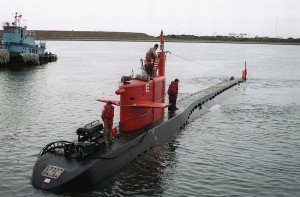In reality, today's bulky and expensive solar panels capture only 10% or so of the sun's energy, but rapid innovation in the US means that the next generation of panels will be much thinner, capture far more of the energy in the sun's light and cost a fraction of what they do today. They may not even be made of silicon. First Solar, the largest manufacturer of thin panels, claims that its products will generate electricity in sunny countries as cheaply as large power stations by 2012.
Other companies are investigating even more efficient ways of capturing the sun's energy, for example the use of long parabolic mirrors to focus light on to a thin tube carrying a liquid, which gets hot enough to drive a steam turbine and generate electricity. Spanish and German companies are installing large-scale solar power plants of this type in North Africa, Spain and the south-west of America; on hot summer afternoons in California, solar power stations are probably already financially competitive with coal. Europe, meanwhile, could get most of its electricity from plants in the Sahara desert. We would need new long-distance power transmission but the technology for providing this is advancing fast, and the countries of North Africa would get a valuable new source of income.
Myth 2: wind power is too unreliable
Actually, during some periods earlier this year the wind provided almost 40% of Spanish power. Parts of northern Germany generate more electricity from wind than they actually need. Northern Scotland, blessed with some of the best wind speeds in Europe, could easily generate 10% or even 15% of the UK's electricity needs at a cost that would comfortably match today's fossil fuel prices.
The intermittency of wind power does mean that we would need to run our electricity grids in a very different way. To provide the most reliable electricity, Europe needs to build better connections between regions and countries; those generating a surplus of wind energy should be able to export it easily to places where the air is still. The UK must invest in transmission cables, probably offshore, that bring Scottish wind-generated electricity to the power-hungry south-east and then continue on to Holland and France. The electricity distribution system must be Europe-wide if we are to get the maximum security of supply.
We will also need to invest in energy storage. At the moment we do this by
pumping water uphill at times of surplus and letting it flow back down the mountain when power is scarce. Other countries are talking of developing "smart grids" that provide users with incentives to consume less electricity when wind speeds are low. Wind power is financially viable today in many countries, and it will become cheaper as turbines continue to grow in size, and manufacturers drive down costs. Some projections see more than 30% of the world's electricity eventually coming from the wind. Turbine manufacture and installation are also set to become major sources of employment, with one trade body predicting that the sector will generate 2m jobs worldwide by 2020.
Myth 3: marine energy is a dead-end
The thin channel of water between the north-east tip of Scotland and Orkney contains some of the most concentrated tidal power in the world. The energy from the peak flows may well be greater than the electricity needs of London. Similarly, the waves off the Atlantic coasts of Spain and Portugal are strong, consistent and able to provide a substantial fraction of the region's power. Designing and building machines that can survive the harsh conditions of fast-flowing ocean waters has been challenging and the past decades have seen repeated disappointments here and abroad. This year we have seen the installation of the first tidal turbine to be successfully connected to the UK electricity grid in Strangford Lough, Northern Ireland, and the first group of large-scale wave power generators 5km off the coast of Portugal, constructed by a Scottish company.
But even though the UK shares with Canada, South Africa and parts of South America some of the best marine energy resources in the world, financial support has been trifling. The London opera houses have had more taxpayer money than the British marine power industry over the past few years. Danish support for wind power helped that country establish worldwide leadership in the building of turbines; the UK could do the same with wave and tidal power.
Myth 4: nuclear power is cheaper than other low-carbon sources of electricity
If we believe that the world energy and environmental crises are as severe as is said, nuclear power stations must be considered as a possible option. But although the disposal of waste and the proliferation of nuclear weapons are profoundly important issues, the most severe problem may be the high and unpredictable cost of nuclear plants.
The new nuclear power station on the island of Olkiluoto in western Finland is a clear example. Electricity production was originally supposed to start this year, but the latest news is that the power station will not start generating until 2012. The impact on the cost of the project has been dramatic. When the contracts were signed, the plant was supposed to cost €3bn (£2.5bn). The final cost is likely to be more than twice this figure and the construction process is fast turning into a nightmare. A second new plant in Normandy appears to be experiencing similar problems. In the US, power companies are backing away from nuclear because of fears over uncontrollable costs.
Unless we can find a new way to build nuclear power stations, it looks as though CO2 capture at coal-fired plants will be a cheaper way of producing low-carbon electricity. A sustained research effort around the world might also mean that cost-effective carbon capture is available before the next generation of nuclear plants is ready, and that it will be possible to fit carbon-capture equipment on existing coal-fired power stations. Finding a way to roll out CO2 capture is the single most important research challenge the world faces today. The current leader, the Swedish power company Vattenfall, is using an innovative technology that burns the coal in pure oxygen rather than air, producing pure carbon dioxide from its chimneys, rather than expensively separating the CO2 from other exhaust gases. It hopes to be operating huge coal-fired power stations with minimal CO2 emissions by 2020.
Myth 5: electric cars are slow and ugly
We tend to think that electric cars are all like the G Wiz vehicle, with a limited range, poor acceleration and an unprepossessing appearance. Actually, we are already very close to developing electric cars that match the performance of petrol vehicles. The Tesla electric sports car, sold in America but designed by Lotus in Norfolk, amazes all those who experience its awesome acceleration. With a price tag of more than $100,000, late 2008 probably wasn't a good time to launch a luxury electric car, but the Tesla has demonstrated to everybody that electric cars can be exciting and desirable. The crucial advance in electric car technology has been in batteries: the latest lithium batteries - similar to the ones in your laptop - can provide large amounts of power for acceleration and a long enough range for almost all journeys.
Batteries still need to become cheaper and quicker to charge, but the UK's largest manufacturer of electric vehicles says that advances are happening faster than ever before. Its urban delivery van has a range of over 100 miles, accelerates to 70mph and has running costs of just over 1p per mile. The cost of the diesel equivalent is probably 20 times as much. Denmark and Israel have committed to develop the full infrastructure for a switch to an all-electric car fleet. Danish cars will be powered by the spare electricity from the copious resources of wind power; the Israelis will provide solar power harvested from the desert.
Myth 6: biofuels are always destructive to the environment
Making some of our motor fuel from food has been an almost unmitigated disaster. It has caused hunger and increased the rate of forest loss, as farmers have sought extra land on which to grow their crops. However the failure of the first generation of biofuels should not mean that we should reject the use of biological materials forever. Within a few years we will be able to turn agricultural wastes into liquid fuels by splitting cellulose, the most abundant molecule in plants and trees, into simple hydrocarbons. Chemists have struggled to find a way of breaking down this tough compound cheaply, but huge amounts of new capital have flowed into US companies that are working on making a petrol substitute from low-value agricultural wastes. In the lead is Range Fuels, a business funded by the venture capitalist Vinod Khosla, which is now building its first commercial cellulose cracking plant in Georgia using waste wood from managed forests as its feedstock.
We shouldn't be under any illusion that making petrol from cellulose is a solution to all the problems of the first generation of biofuels. Although cellulose is abundant, our voracious needs for liquid fuel mean we will have to devote a significant fraction of the world's land to growing the grasses and wood we need for cellulose refineries. Managing cellulose production so that it doesn't reduce the amount of food produced is one of the most important issues we face.
Myth 7: climate change means we need more organic agriculture
The uncomfortable reality is that we already struggle to feed six billion people. Population numbers will rise to more than nine billion by 2050. Although food production is increasing slowly, the growth rate in agricultural productivity is likely to decline below population increases within a few years. The richer half of the world's population will also be eating more meat. Since animals need large amounts of land for every unit of meat they produce, this further threatens food production for the poor. So we need to ensure that as much food as possible is produced on the limited resources of good farmland. Most studies show that yields under organic cultivation are little more than half what can be achieved elsewhere. Unless this figure can be hugely improved, the implication is clear: the world cannot feed its people and produce huge amounts of cellulose for fuels if large acreages are converted to organic cultivation.
Myth 8: zero carbon homes are the best way of dealing with greenhouse gas emissions from buildings
Buildings are responsible for about half the world's emissions; domestic housing is the most important single source of greenhouse gases. The UK's insistence that all new homes are "zero carbon" by 2016 sounds like a good idea, but there are two problems. In most countries, only about 1% of the housing stock is newly built each year. Tighter building regulations have no effect on the remaining 99%. Second, making a building genuinely zero carbon is extremely expensive. The few prototype UK homes that have recently reached this standard have cost twice as much as conventional houses.
Just focusing on new homes and demanding that housebuilders meet extremely high targets is not the right way to cut emissions. Instead, we should take a lesson from Germany. A mixture of subsidies, cheap loans and exhortation is succeeding in getting hundreds of thousands of older properties eco-renovated each year to very impressive standards and at reasonable cost. German renovators are learning lessons from the PassivHaus movement, which has focused not on reducing carbon emissions to zero, but on using painstaking methods to cut emissions to 10 or 20% of conventional levels, at a manageable cost, in both renovations and new homes. The PassivHaus pioneers have focused on improving insulation, providing far better air-tightness and warming incoming air in winter, with the hotter stale air extracted from the house. Careful attention to detail in both design and building work has produced unexpectedly large cuts in total energy use. The small extra price paid by householders is easily outweighed by the savings in electricity and gas. Rather than demanding totally carbon-neutral housing, the UK should push a massive programme of eco-renovation and cost-effective techniques for new construction.
Myth 9: the most efficient power stations are big
Large, modern gas-fired power stations can turn about 60% of the energy in fuel into electricity. The rest is lost as waste heat.
Even though 5-10% of the electricity will be lost in transmission to the user, efficiency has still been far better than small-scale local generation of power. This is changing fast.
New types of tiny combined heat and power plants are able to turn about half the energy in fuel into electricity, almost matching the efficiency of huge generators. These are now small enough to be easily installed in ordinary homes. Not only will they generate electricity but the surplus heat can be used to heat the house, meaning that all the energy in gas is productively used. Some types of air conditioning can even use the heat to power their chillers in summer.
We think that microgeneration means wind turbines or solar panels on the roof, but efficient combined heat and power plants are a far better prospect for the UK and elsewhere. Within a few years, we will see these small power plants, perhaps using cellulose-based renewable fuels and not just gas, in many buildings. Korea is leading the way by heavily subsidising the early installation of fuel cells at office buildings and other large electricity users.
Myth 10: all proposed solutions to climate change need to be hi-tech
The advanced economies are obsessed with finding hi-tech solutions to reducing greenhouse gas emissions. Many of these are expensive and may create as many problems as they solve. Nuclear power is a good example. But it may be cheaper and more effective to look for simple solutions that reduce emissions, or even extract existing carbon dioxide from the air. There are many viable proposals to do this cheaply around the world, which also often help feed the world's poorest people. One outstanding example is to use a substance known as biochar to sequester carbon and increase food yields at the same time.
Biochar is an astonishing idea. Burning agricultural wastes in the absence of air leaves a charcoal composed of almost pure carbon, which can then be crushed and dug into the soil. Biochar is extremely stable and the carbon will stay in the soil unchanged for hundreds of years. The original agricultural wastes had captured CO2 from the air through the photosynthesis process; biochar is a low-tech way of sequestering carbon, effectively for ever. As importantly, biochar improves fertility in a wide variety of tropical soils. Beneficial micro-organisms seem to crowd into the pores of the small pieces of crushed charcoal. A network of practical engineers around the tropical world is developing the simple stoves needed to make the charcoal. A few million dollars of support would allow their research to benefit hundreds of millions of small farmers at the same time as extracting large quantities of CO2 from the atmosphere.
• Chris Goodall's new book, Ten Technologies to Save the Planet, is published by Profile books, priced £9.99.
Original here
 Cameras are one of the hottest subjects for geek gadget envy, with increasingly evolved camera-phones boasting up to five megapixels, while dedicated camera-carriers brag about the ridiculously high resolution offered by eight megapixels. Which is why MIT took the time to remind us all who the alpha nerds are, building a billion-pixel camera. Which watches out for threats to Earth, as if the sheer ludicrous size of the camera wasn't cool enough.
Cameras are one of the hottest subjects for geek gadget envy, with increasingly evolved camera-phones boasting up to five megapixels, while dedicated camera-carriers brag about the ridiculously high resolution offered by eight megapixels. Which is why MIT took the time to remind us all who the alpha nerds are, building a billion-pixel camera. Which watches out for threats to Earth, as if the sheer ludicrous size of the camera wasn't cool enough.











